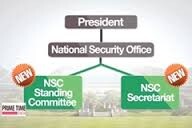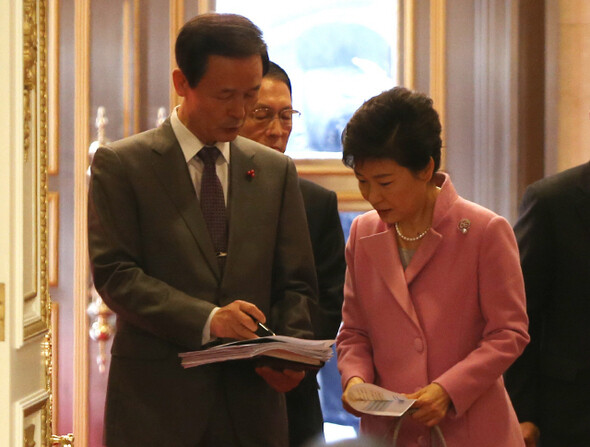hankyoreh
Links to other country sites 다른 나라 사이트 링크
Park reshuffles security officials to respond to changing N. Korean threat

By Seok Jin-hwan, Blue House correspondent
In order to respond to the rapidly changing international climate around the Korean peninsula, President Park Geun-hye approved the establishment of a standing committee for the National Security Council (NSC) on Dec. 20 to oversee the government’s diplomatic and security policy as well as a secretariat to carry out the day-to-day work.
Chief of the Blue House National Security Office (equivalent in rank to a minister) will serve as the chair of the standing committee. Since the NSC standing committee will involve the participation of all the government agencies related to foreign affairs and security - including the National Intelligence Service, the Ministry of Foreign Affairs, the Unification Ministry, the Defense Ministry, and the Ministry of Security and Public Administration - this organizational reshuffle could essentially concentrate the main authority for diplomacy and security in the Blue House national security office.
National Security Chief Kim Jang-soo, who hitherto had been the same rank as other government ministers, has effectively become the person in charge of diplomacy and security.
In addition to the establishment of a NSC secretariat, which will assume a support role and whose chief will be equivalent to a vice-minister in rank, the national security office has been significantly expanded, giving it a major boost in status. There will be two management positions at the national security office. One of them will be filled by the head of the NSC secretariat, and the Blue House’s senior Secretary for Foreign Affairs and National Security will assume the other.
In addition, the international cooperation secretary office under the national security office will become the policy management secretary office, and a security strategy secretary office will be established as well. If this is implemented, the national security office will have a total of four secretary offices under two managers: the crisis management secretary office, the information integration secretary office, the policy management secretary office, and the security strategy secretary office. The position of policy management secretary will be held by the head of the NSC secretariat.
In regard to the reorganization, Blue House senior Secretary for Foreign Affairs and National Security Ju Cheol-gi said, “The situation has been grave since North Korea’s execution of Jang Song-thaek on Dec. 12. On Dec. 19, North Korea used demonstrations by conservative organizations as a pretext for issuing a threat in the name of the National Defense Commission that it could strike without warning. This is one example of how the danger of the situation on the Korean peninsula has been increasing as of late.”
“Significant changes are also occurring in the strategic environment in Northeast Asia, with conflict increasing between the countries surrounding the Korean peninsula,” Ju continued. “The reorganization comes as a response to these changes.”
The NSC standing committee that is being established will discuss pending issues in foreign affairs and national security each week and devise countermeasures, reporting these to the president. The new secretariat will assist in preparing for the NSC which the president presides over, the standing committee, and the working-level management meeting. It will also verify whether the resolutions made during these meetings are being carried out.
“This reshuffle has unified the system of security meetings and also created a system for the decision-making process for security policy. This will enable us to respond proactively and effectively to rapidly changing situations,” Ju said.
Formally speaking, the establishment of the NSC standing committee and the appointment of Kim Jang-soo as its chair - the crux of the reorganization - is very similar to how unification, foreign affairs, and national security matters were run during the administrations of former presidents Kim Dae-jung and Roh Moo-hyun. During the term of Kim Dae-jung, the NSC standing committee was established under the lead of former minister Lim Dong-won, who managed the Sunshine Policy toward North Korea during the five years of Kim’s administration. During the Roh Moo-hyun administration, former ministers Lee Jong-seok and Jeong Dong-yeong supervised diplomacy and foreign affairs during their tenures as chair of the NSC standing committee.
However, in the sense that the head of the standing committee is not a minister dealing with regular work but rather a Blue House advisor, it appears that the wishes of President Park will be given priority by the committee. With a former member of the military serving as chair of the committee, it is also possible that the views of the Unification Ministry and the Foreign Affairs Ministry may be disregarded.
Along with pushing for a revision of the National Security Council Act, which is necessary for establishing the NSC standing committee and the secretariat, the Blue House decided to deliberate with each department and start moving to revise regulations in order to reorganize the national security office and to increase the number of staff.

Please direct questions or comments to [english@hani.co.kr]

Editorial・opinion
![[Column] Season 2 of special prosecutor probe may be coming to Korea soon [Column] Season 2 of special prosecutor probe may be coming to Korea soon](https://flexible.img.hani.co.kr/flexible/normal/500/300/imgdb/original/2024/0426/3317141030699447.jpg) [Column] Season 2 of special prosecutor probe may be coming to Korea soon
[Column] Season 2 of special prosecutor probe may be coming to Korea soon![[Column] Park Geun-hye déjà vu in Yoon Suk-yeol [Column] Park Geun-hye déjà vu in Yoon Suk-yeol](https://flexible.img.hani.co.kr/flexible/normal/500/300/imgdb/original/2024/0424/651713945113788.jpg) [Column] Park Geun-hye déjà vu in Yoon Suk-yeol
[Column] Park Geun-hye déjà vu in Yoon Suk-yeol- [Editorial] New weight of N. Korea’s nuclear threats makes dialogue all the more urgent
- [Guest essay] The real reason Korea’s new right wants to dub Rhee a founding father
- [Column] ‘Choson’: Is it time we start referring to N. Korea in its own terms?
- [Editorial] Japan’s rewriting of history with Korea has gone too far
- [Column] The president’s questionable capacity for dialogue
- [Column] Are chaebol firms just pizza pies for families to divvy up as they please?
- [Column] Has Korea, too, crossed the Rubicon on China?
- [Correspondent’s column] In Japan’s alliance with US, echoes of its past alliances with UK
Most viewed articles
- 1[Column] Season 2 of special prosecutor probe may be coming to Korea soon
- 2‘We must say no’: Seoul defense chief on Korean, USFK involvement in hypothetical Taiwan crisis
- 3Is N. Korea threatening to test nukes in response to possible new US-led sanctions body?
- 4Division commander ordered troops to enter raging flood waters before Marine died, survivor says
- 5Amnesty notes ‘erosion’ of freedom of expression in Korea in annual human rights report
- 6Is Japan about to snatch control of Line messenger from Korea’s Naver?
- 7No good, very bad game for Korea puts it out of Olympics for first time since 1988
- 8[Editorial] Korea’s surprise Q1 growth requires objective assessment, not blind fanfare
- 9N. Korean delegation’s trip to Iran shows how Pyongyang is leveraging ties with Moscow
- 10Korea’s 1.3% growth in Q1 signals ‘textbook’ return to growth, says government